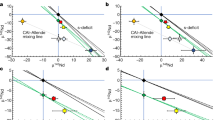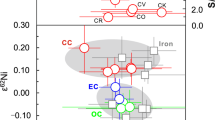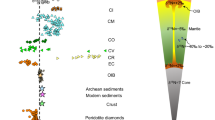Abstract
Relative to the CI chondrite class of meteorites (widely thought to be the ‘building blocks’ of the terrestrial planets), the Earth is depleted in volatile elements. For most elements this depletion is thought to be a solar nebular signature, as chondrites show depletions qualitatively similar to that of the Earth1. On the other hand, as lead is a volatile element, some Pb may also have been lost after accretion. The unique 206Pb/204Pb and 207Pb/204Pb ratios of the Earth’s mantle suggest that some lead was lost about 50 to 130 Myr after Solar System formation2,3,4. This has commonly been explained by lead lost via the segregation of a sulphide melt to the Earth’s core5,6,7, which assumes that lead has an affinity towards sulphide. Some models, however, have reconciled the Earth’s lead deficit with volatilization8. Whichever model is preferred, the broad coincidence of U–Pb model ages with the age of the Moon9,10,11 suggests that lead loss may be related to the Moon-forming impact. Here we report partitioning experiments in metal–sulphide–silicate systems. We show that lead is neither siderophile nor chalcophile enough to explain the high U/Pb ratio of the Earth’s mantle as being a result of lead pumping to the core. The Earth may have accreted from initially volatile-depleted material, some lead may have been lost to degassing following the Moon-forming giant impact, or a hidden reservoir exists in the deep mantle with lead isotope compositions complementary to upper-mantle values; it is unlikely though that the missing lead resides in the core.
This is a preview of subscription content, access via your institution
Access options
Subscribe to this journal
Receive 51 print issues and online access
$199.00 per year
only $3.90 per issue
Buy this article
- Purchase on Springer Link
- Instant access to full article PDF
Prices may be subject to local taxes which are calculated during checkout





Similar content being viewed by others
References
Palme, H. & O’Neill, H. S. in The Mantle and Core (ed. Carlson, R. W.) 1–38 (Treatise on Geochemistry 2, Elsevier, 2003)
Galer, S. J. G. & Goldstein, S. L. in Earth Processes: Reading the Isotope Code (eds Basu, A. & Hart, S.) 75–98 (American Geophysical Union, 1996)
Hofmann, A. W. in The Mantle and Core (ed. Carlson, R. W.) 61–101 (Treatise on Geochemistry 2, Elsevier, 2003)
Allègre, C. J., Manhès, G. & Göpel, C. The major differentiation of the Earth at ∼ 4.45 Ga. Earth Planet. Sci. Lett. 267, 386–398 (2008)
Oversby, V. M. & Ringwood, A. E. Time of formation of the Earth’s core. Nature 234, 463–465 (1971)
Wood, B. J. & Halliday, A. N. Cooling of the Earth and core formation after the giant impact. Nature 437, 1345–1348 (2005)
Wood, B. J., Walter, M. J. & Wade, J. Accretion of the Earth and segregation of its core. Nature 441, 825–833 (2006)
Jacobsen, S. B. The Hf-W isotopic system and the origin of the earth and moon. Annu. Rev. Earth Planet. Sci. 33, 531–570 (2005)
Kleine, T., Münker, C., Mezger, K. & Palme, H. Rapid accretion and early core formation on asteroids and the terrestrial planets from Hf–W chronometry. Nature 418, 952–955 (2002)
Kleine, T. et al. Hf-W chronometry of lunar metals and the age and early differentiation of the Moon. Science 310, 1671–1674 (2005)
Touboul, M. et al. Late formation and prolonged differentiation of the Moon inferred from W isotopes in lunar metals. Nature 450, 1206–1209 (2007)
O’Neill, H. & St. C The origin of the Moon and the early history of the Earth - A chemical model. Part 2: The Earth. Geochim. Cosmochim. Acta 55, 1159–1172 (1991)
Hart, S. R. & Gaetani, R. A. Mantle Pb paradoxes: the sulfide solution. Contrib. Mineral. Petrol. 152, 295–308 (2006)
Malavergne, V. et al. New high-pressure and high-temperature metal/silicate partitioning of U and Pb: Implications for the cores of the Earth and Mars. Geochim. Cosmochim. Acta 71, 2637–2655 (2007)
Petitet, J. P., Petot, C. & Petot-Ervas, G. Influence of pressure on the activity of PbO in an equimolar molten PbO-SiO2 mixture. Chem. Geol. 62, 31–34 (1987)
Ohtani, E., Yurimoto, H. & Seto, S. Element partitioning between metallic liquid, silicate liquid, and lower-mantle minerals: implications for core formation of the Earth. Phys. Earth Planet. Inter. 100, 97–114 (1997)
McDonough, W. F. in The Mantle and Core (ed. Carlson, R. W.) 547–568 (Treatise on Geochemistry 2, Elsevier, 2003)
Allegre, C. J., Manhes, G. & Göpel, C. The age of the Earth. Geochim. Cosmochim. Acta 59, 1445–1456 (1995)
Palme, H. & Jones, A. in Meteorites, Comets and Planets (ed. Davis A. M.) 41–61 (Treatise on Geochemistry 1, Elsevier, 2003)
Yin, Q.-Z. & Jacobsen, S. B. Does U–Pb date Earth’s core formation? Nature 444 E1 doi: 10.1038/nature05358 (2006)
Solomatov, V. S. in Origin of the Earth and Moon (eds Canup, R. & Righter, K.) 323–338 (Univ. Arizona Press, 2000)
Porcelli, D., Woolum, D. & Cassen, P. Deep Earth rare gases: initial inventories, capture from the solar nebula, and losses during Moon formation. Earth Planet. Sci. Lett. 193, 237–251 (2001)
Ozima, H. & Podosek, F. A. Formation age of the earth from 129I/127I and 244Pu/238U systematics and the missing Xe. J. Geophys. Res. 104, 25493–25499 (1999)
Tolstikhin, I. & Hofmann, A. W. Early crust on top of the Earth’s core. Phys. Earth Planet. Inter. 148, 109–130 (2005)
Rohrbach, A. et al. Metal saturation in the upper mantle. Nature 449, 456–458 (2007)
O’Neill, H. & St. C. et al. Mössbauer spectroscopy of mantle transition zone phases and determination of minimum Fe3+ content. Am. Mineral. 78, 456–460 (1993)
Frost, D. J. et al. Experimental evidence for the existence of iron-rich metal in the Earth’s lower mantle. Nature 428, 409–412 (2004)
Schuth, S. et al. Geochemical constraints on the petrogenesis of arc picrites and basalts, New Georgia Group, Solomon Islands. Contrib. Mineral. Petrol. 148, 288–304 (2004)
Jones, J. H. & Drake, M. J. Geochemical constraints on core formation in the Earth. Nature 322, 221–228 (1986)
Acknowledgements
The paper benefited from our discussions with F. Tomaschek, E. E. Scherer, A. Rohrbach, R. Fonseca and K. Mezger, as well as from a review by S. B. Jacobsen. Financial support from the German Research Council through the Priority Programme ‘Mars and the Terrestrial Planets’ to C.B. and C.M. is acknowledged.
Author information
Authors and Affiliations
Corresponding author
Supplementary information
Supplementary Information
This file contains Supplementary Notes, Supplementary Figure 1 with Legend and Supplementary Tables S1-S2. (PDF 1130 kb)
Rights and permissions
About this article
Cite this article
Lagos, M., Ballhaus, C., Münker, C. et al. The Earth’s missing lead may not be in the core. Nature 456, 89–92 (2008). https://doi.org/10.1038/nature07375
Received:
Accepted:
Issue Date:
DOI: https://doi.org/10.1038/nature07375
This article is cited by
-
Petrogenesis of the Neoarchean zincian chromite within ultramafic xenoliths, Bastar Craton, India
Acta Geochimica (2023)
-
Preparation of Al2O3–Cr2O3 Solid Solutions as Buoyancy Markers and Their High Pressure Synchrotron X-ray Diffraction Analysis
Pure and Applied Geophysics (2022)
-
Silicate Earth’s missing niobium may have been sequestered into asteroidal cores
Nature Geoscience (2017)
-
The great sulfur depletion of Earth’s mantle is not a signature of mantle–core equilibration
Contributions to Mineralogy and Petrology (2017)
-
Unradiogenic lead in Earth’s upper mantle
Nature Geoscience (2012)
Comments
By submitting a comment you agree to abide by our Terms and Community Guidelines. If you find something abusive or that does not comply with our terms or guidelines please flag it as inappropriate.



